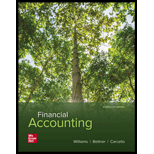
a.
Ascertain the operating profit before tax for each division using the market transfer price of $135.
a.
Explanation of Solution
Ascertain the operating profit before tax for each division using the market transfer price of $135 as follows:
|
Entire Company |
Frame Division |
Works Division | |
| Sales | $1,162,500 | $742,500 | $825,000 |
| Variable Costs | 651,000 | 396,000 | 660,000 |
| Contribution Margin | $511,500 | $346,500 | $165,000 |
| Fixed Costs | 384,000 | 280,000 | 104,000 |
| Operating Profit | $127,500 | $66,500 | $61,000 |
Table (1)
Calculate the sales of Frame Division.
Calculate the sales of Works Division.
Calculate the sales of Entire Company.
Calculate the variable cost of Frame Division.
Calculate the variable cost of Works Division.
Calculate the variable cost of Entire Company.
b.
Ascertain the operating profit before tax for each division using the transfer price of $130, as suggested by the manager of the Works Division.
b.
Explanation of Solution
Ascertain the operating profit before tax for each division using the transfer price of $130, as suggested by the manager of the Works Division as follows:
|
Entire Company |
Frame Division |
Works Division | |
| Sales | $1,162,500 | $727,500 | $825,000 |
| Variable Costs | 651,000 | 396,000 | 645,000 |
| Contribution Margin | $511,500 | $331,500 | $180,000 |
| Fixed Costs | 384,000 | 280,000 | 104,000 |
| Operating Profit | $127,500 | $51,500 | $76,000 |
Table (2)
Calculate the sales of Frame Division.
Calculate the sales of Works Division.
Calculate the sales of Entire Company.
Calculate the variable cost of Frame Division.
Calculate the variable cost of Works Division.
c.
Discuss the manner in which the company’s net income affected under the two transfer pricing scenarios.
c.
Explanation of Solution
Discuss the manner in which the company’s net income affected under the two transfer pricing scenarios as follows:
Accounting entries that show the flow of goods between the departments are generated by the transfer prices. One department records the transfer price as revenue while on the other hand; the same is treated as an expense by the other department. These entries of revenue and expense are cancelled out for the entire company and hence, internal transfer prices do not have a direct effect on the net income of the company.
d.
Discuss whether it would be more beneficial to the company if the Frame Division sold casings externally and the Works Division purchased casings from an outside supplier.
d.
Explanation of Solution
Calculate the pre-tax operating profit, using the external sale price and purchase price for the casings as follows:
|
Entire Company |
Frame Division |
Works Division | |
| Sales | $1,567,500 | $742,500 | $825,000 |
| Variable Costs | 1,071,000 | 396,000 | 675,000 |
| Contribution Margin | $496,500 | $346,500 | $150,000 |
| Fixed Costs | 384,000 | 280,000 | 104,000 |
| Operating Profit | $112,500 | $66,500 | $46,000 |
Table (3)
Calculate the sales of Frame Division.
Calculate the sales of Works Division.
Calculate the sales of Entire Company.
Calculate the variable cost of Frame Division.
Calculate the variable cost of Works Division.
Calculate the variable cost of Entire Company.
The company earns $15,000 more in operating profit if the Works Division purchases the casings from the Frame Division and hence, as a whole it is more beneficial to the company.
Want to see more full solutions like this?
Chapter 22 Solutions
Financial Accounting
- Thompson & Sons values its goodwill at four years' purchase of the last five years' average profit. The recorded profits for the last five years were R.O 62,000, R.O 45,000, R.O 38,000, R.O 52,000, and R.O 43,000, respectively. Find out the value of goodwill.helparrow_forwardCan you solve this financial accounting problem with appropriate steps and explanations?arrow_forwardNonearrow_forward

 AccountingAccountingISBN:9781337272094Author:WARREN, Carl S., Reeve, James M., Duchac, Jonathan E.Publisher:Cengage Learning,
AccountingAccountingISBN:9781337272094Author:WARREN, Carl S., Reeve, James M., Duchac, Jonathan E.Publisher:Cengage Learning, Accounting Information SystemsAccountingISBN:9781337619202Author:Hall, James A.Publisher:Cengage Learning,
Accounting Information SystemsAccountingISBN:9781337619202Author:Hall, James A.Publisher:Cengage Learning, Horngren's Cost Accounting: A Managerial Emphasis...AccountingISBN:9780134475585Author:Srikant M. Datar, Madhav V. RajanPublisher:PEARSON
Horngren's Cost Accounting: A Managerial Emphasis...AccountingISBN:9780134475585Author:Srikant M. Datar, Madhav V. RajanPublisher:PEARSON Intermediate AccountingAccountingISBN:9781259722660Author:J. David Spiceland, Mark W. Nelson, Wayne M ThomasPublisher:McGraw-Hill Education
Intermediate AccountingAccountingISBN:9781259722660Author:J. David Spiceland, Mark W. Nelson, Wayne M ThomasPublisher:McGraw-Hill Education Financial and Managerial AccountingAccountingISBN:9781259726705Author:John J Wild, Ken W. Shaw, Barbara Chiappetta Fundamental Accounting PrinciplesPublisher:McGraw-Hill Education
Financial and Managerial AccountingAccountingISBN:9781259726705Author:John J Wild, Ken W. Shaw, Barbara Chiappetta Fundamental Accounting PrinciplesPublisher:McGraw-Hill Education





